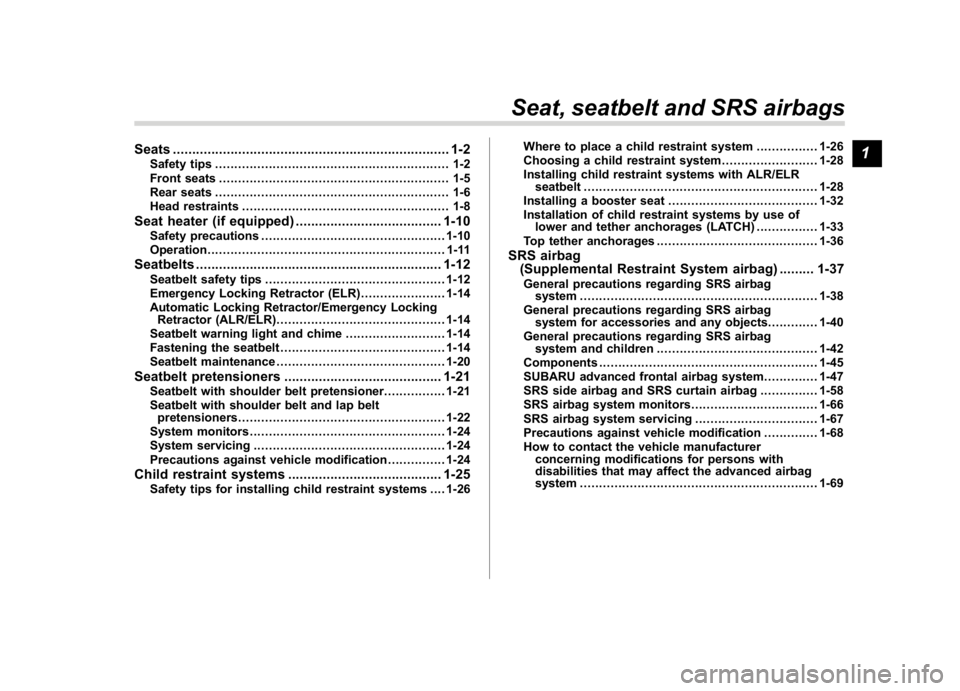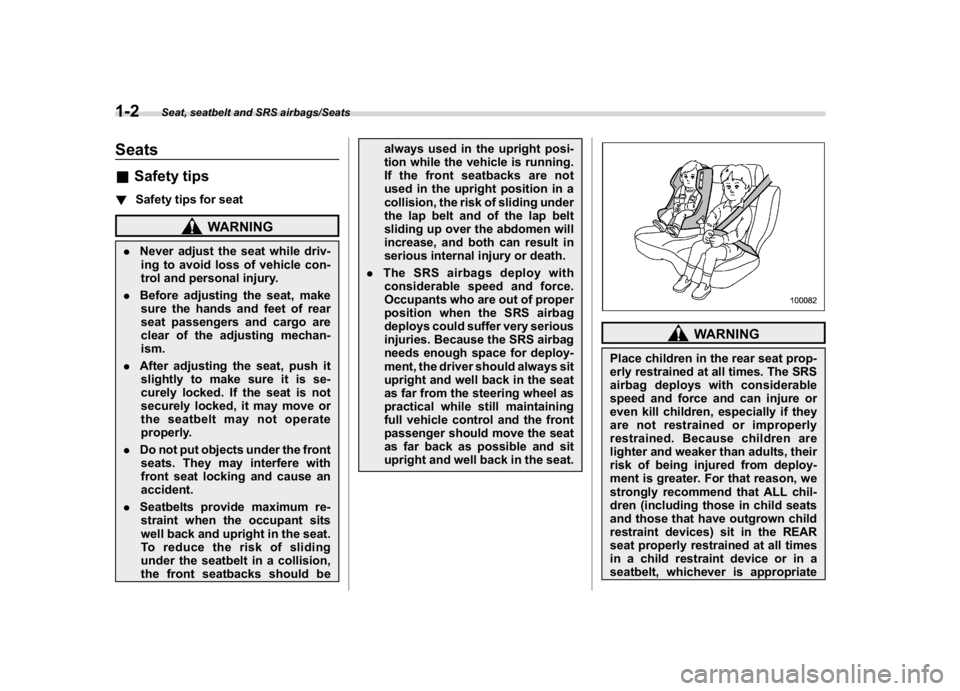2018 SUBARU CROSSTREK airbag
[x] Cancel search: airbagPage 4 of 474

(3,1)
北米Model "A1320BE-C" EDITED: 2017/ 10/ 10
Warranties&Warranties for U.S.A.SUBARU vehicles distributed by Subaru of
America, Inc. and sold at retail by an
authorized SUBARU dealer in the United
States come with the following warranties:
.SUBARU Limited Warranties
.Federal Emission Control Systems
Warranties
.California Emissions Control Sys-
tems Warranties
All warranty information, including applic-
ability, details of coverage and exclusions,
is in the“Warranty and Maintenance
Booklet”. Read these warranties carefully.&Warranties for CanadaSUBARU vehicles distributed by Subaru
Canada, Inc. and sold at retail by an
authorized SUBARU dealer in Canada
come with the following warranties:
.SUBARU Limited Warranty
.Emission Control System Warranty
All warranty information, including applic-
ability, details of coverage and exclusions,
is in the“Warranty and Service Booklet”.
Read these warranties carefully.
&Warranties except for U.S.A.
and CanadaAll warranty information, including details
of coverage and exclusions, is in the
“Warranty and Maintenance Booklet”.
Read these warranties carefully.
How to use this Owner’s
Manual&Using your Owner’s ManualBefore you operate your vehicle, carefully
read this manual. To protect yourself and
extend the service life of your vehicle,
follow the instructions in this manual.
Failure to observe these instructions may
result in serious injury and damage to your
vehicle.
This manual is composed of fourteen
chapters. Each chapter begins with a brief
table of contents, so you can usually tell at
a glance if that chapter contains the
information you want.
Chapter 1: Seat, seatbelt and SRS air-
bags
This chapter informs you how to use the
seat and seatbelt and contains precau-
tions for the SRS airbags.
Chapter 2: Keys and doors
This chapter informs you how to operate
the keys, locks and windows.
Chapter 3: Instruments and controls
This chapter informs you about the opera-
tion of instrument panel indicators and how
to use the instruments and other switches.
–CONTINUED–
1
0
Page 7 of 474

(6,1)
北米Model "A1320BE-C" EDITED: 2017/ 10/ 10
Vehicle symbolsThere are some of the symbols you may
see on your vehicle.
For warning and indicator lights, refer to
“Warning and indicator lights”F23.
Mark Name
WARNINGCAUTIONRead these instructions care-
fullyWear eye protectionBattery fluid contains sulfuric
acidKeep children awayKeep flames awayPrevent explosions
Safety precautions when
driving&Seatbelt and SRS airbag
WARNING
.All persons in the vehicle must
fasten their seatbelts BEFORE
the vehicle starts to move. Other-
wise, the possibility of serious
injury becomes greater in the
event of a sudden stop or acci-
dent.
.To obtain maximum protection in
the event of an accident, the
driver and all passengers must
always wear seatbelts when in
the vehicle. The SRS (Supple-
mental Restraint System) airbag
does not do away with the need to
fasten seatbelts. In combination
with the seatbelts, it offers the
best combined protection in case
of a serious accident.
Not wearing a seatbelt increases
the chance of severe injury or
death in a crash even when the
vehicle has the SRS airbag..The SRS airbags deploy with
considerable speed and force.
Occupants who are out of proper
position when the SRS airbag
deploys could suffer very serious
injuries. Because the SRS airbag
needs enough space for deploy-
ment, the driver should always sit
upright and well back in the seat
as far from the steering wheel as
practical while still maintaining
full vehicle control and the front
passenger should move the seat
as far back as possible and sit
upright and well back in the seat.
For instructions and precautions, carefully
read the following sections.
.For the seatbelt system, refer to“Seat-
belts”F1-12.
.For the SRS airbag system, refer to
“SRS airbag (Supplemental Restraint Sys-
tem airbag)”F1-37.
&Child safety
WARNING
.Never hold a child on your lap or
in your arms while the vehicle is
moving. The passenger cannot
protect the child from injury in a
4
Page 8 of 474

(7,1)
北米Model "A1320BE-C" EDITED: 2017/ 10/ 10
collision, because the child will
be caught between the passen-
ger and objects inside the vehi-
cle.
.While riding in the vehicle, infants
and small children should always
be seated in the REAR seat in an
infant or child restraint system
which is appropriate for the
child’s age, height and weight. If
a child is too big for a child
restraint system, the child should
sit in the REAR seat and be
restrained using the seatbelts.
According to accident statistics,
children are safer when properly
restrained in the rear seating
positions than in the front seating
positions. Never allow a child to
stand up or kneel on the seat.
.Place children in the REAR seat
properly restrained at all times in
a child restraint device or in a
seatbelt. The SRS airbag deploys
with considerable speed and
force and can injure or even kill
children, especially if they are not
restrained or improperly re-
strained. Because children are
lighter and weaker than adults,
their risk of being injured from
deployment is greater..NEVER INSTALL A FORWARD OR
REARWARD FACING CHILD
SEAT IN THE FRONT SEAT.
DOING SO RISKS SERIOUS IN-
JURY OR DEATH TO THE CHILD
BY PLACING THE CHILD’S HEAD
TOO CLOSE TO THE SRS AIR-
BAG.
.Always turn the child safety locks
to the“LOCK”position when
children sit in the rear seat.
Serious injury could result if a
child accidentally opens the door
and falls out. Refer to“Child
safety locks”F2-28.
.Always lock the passenger’s win-
dows using the lock switch when
children are riding in the vehicle.
Failure to follow this procedure
could result in injury to a child
operating the power window. Re-
fer to“Windows”F2-28.
.Never leave unattended children,
adults or animals in the vehicle.
They could accidentally injure
themselves or others through
inadvertent operation of the ve-
hicle. Also, on hot or sunny days,
temperature in a closed vehicle
could quickly become high en-
ough to cause severe or possibly
fatal injuries to them..When leaving the vehicle, close
all windows and lock all doors.
For instructions and precautions, carefully
read the following sections.
.For the seatbelt system, refer to“Seat-
belts”F1-12.
.For the child restraint system, refer to
“Child restraint systems”F1-25.
.For the SRS airbag system, refer to
“SRS airbag (Supplemental Restraint Sys-
tem airbag)”F1-37.
–CONTINUED–
5
0
Page 14 of 474

(1,1)
北米Model "A1320BE-C" EDITED: 2017/ 10/ 10
Table of contentsSeat, seatbelt and SRS airbags
1
Keys and doors
2
Instruments and controlsClimate control
4
Audio
5
Interior equipment
6
Starting and operating
7
Driving tips
8
In case of emergency
9
Appearance care
10
Maintenance and service
11
Specifications
12
Consumer information and Reporting safety defects
13
Index
143
Page 20 of 474

(19,1)
北米Model "A1320BE-C" EDITED: 2017/ 10/ 10
1) Audio control switches*
2) INFO button for type A multi-function
display (black and white) (page 3-42)/
INFO button for type B multi-function
display (color LCD) (page 3-47)
3) Cruise control (page 7-48)
4) Shift paddle (page 7-26)
5) Heated Steering Wheel switch (page 3-
91)
6) SRS airbag (page 1-37)
7) Horn (page 3-92)
8) Combination meter display (color LCD)
control switches (page 3-33)
9) Talk switch for voice command system*/
Hands-free phone switches**: For details about how to use the
switches, refer to the separate naviga-
tion/audio Owner’s Manual.
–CONTINUED–
17
0
Page 26 of 474

(25,1)
北米Model "A1320BE-C" EDITED: 2017/ 10/ 10
&Warning and indicator lights
Mark Name Page
Seatbelt warning light 3-13Front passenger’s
seatbelt warning light3-13SRS airbag system
warning light3-15Front passenger’s
frontal airbag ON indi-
cator3-15Front passenger’s
frontal airbag OFF in-
dicator3-15CHECK ENGINE
warning light/Malfunc-
tion indicator light3-15Coolant temperature
low indicator light/
Coolant temperature
high warning light3-16Charge warning light 3-17Oil pressure warning
light3-17Engine oil level warn-
ing light3-18Mark Name Page
AT OIL TEMP warning
light (CVT models)3-18ABS warning light 3-20Brake system warning
light3-21
/
Door open warning
light3-22AWD warning light
(CVT models)3-22Power steering warn-
ing light3-23Hill start assist warning
light/Hill start assist
OFF indicator light3-22Vehicle Dynamics
Control warning light/
Vehicle Dynamics
Control operation indi-
cator light3-23Vehicle Dynamics
Control OFF indicator
light3-24Turn signal indicator
lights3-30High beam indicator
light3-30Mark Name Page
High beam assist indi-
cator light (green) (if
equipped)3-30
High Beam Assist
warning indicator (yel-
low) (if equipped)3-30Automatic headlight
beam leveler warning
light (if equipped)3-31Steering Responsive
Headlight warning
light/Steering Respon-
sive Headlight OFF in-
dicator light (if
equipped)3-31Front fog light indicator
light (if equipped)3-31Access key warning
indicator (if equipped)3-25Security indicator light 3-29Headlight indicator
light (if equipped)3-31Cruise control indica-
tor light (if equipped)3-31Cruise control set indi-
cator light (if equipped)3-31
–CONTINUED–
23
0
Page 30 of 474

(31,1)
北米Model "A1320BE-C" EDITED: 2017/ 10/ 10
Seats........................................................................1-2
Safety tips............................................................. 1-2
Front seats............................................................ 1-5
Rear seats............................................................. 1-6
Head restraints...................................................... 1-8
Seat heater (ifequipped)......................................1-10
Safety precautions................................................1-10
Operation.............................................................. 1-11
Seatbelts................................................................1-12
Seatbelt safety tips...............................................1-12
Emergency Locking Retractor (ELR)......................1-14
Automatic Locking Retractor/Emergency Locking
Retractor (ALR/ELR)............................................1-14
Seatbelt warning light and chime..........................1-14
Fastening the seatbelt...........................................1-14
Seatbelt maintenance............................................1-20
Seatbelt pretensioners.........................................1-21
Seatbelt with shoulder belt pretensioner................1-21
Seatbelt with shoulder belt and lap belt
pretensioners......................................................1-22
System monitors...................................................1-24
System servicing..................................................1-24
Precautions against vehicle modification...............1-24
Child restraint systems........................................1-25
Safety tips for installing child restraint systems....1-26Where to place a child restraint system................1-26
Choosing a child restraint system.........................1-28
Installing child restraint systems with ALR/ELR
seatbelt.............................................................1-28
Installing a booster seat.......................................1-32
Installation of child restraint systems by use of
lower and tether anchorages (LATCH)................1-33
Top tether anchorages..........................................1-36
SRS airbag
(Supplemental Restraint Systemairbag).........1-37
General precautions regarding SRS airbag
system..............................................................1-38
General precautions regarding SRS airbag
system for accessories and any objects.............1-40
General precautions regarding SRS airbag
system and children..........................................1-42
Components.........................................................1-45
SUBARU advanced frontal airbag system..............1-47
SRS side airbag and SRS curtain airbag...............1-58
SRS airbag system monitors.................................1-66
SRS airbag system servicing ................................1-67
Precautions against vehicle modification..............1-68
How to contact the vehicle manufacturer
concerning modifications for persons with
disabilities that may affect the advanced airbag
system..............................................................1-69Seat, seatbelt and SRS airbags
1
Page 31 of 474

(32,1)
北米Model "A1320BE-C" EDITED: 2017/ 10/ 10
Seats&Safety tips!Safety tips for seat
WARNING
.Never adjust the seat while driv-
ing to avoid loss of vehicle con-
trol and personal injury.
.Before adjusting the seat, make
sure the hands and feet of rear
seat passengers and cargo are
clear of the adjusting mechan-
ism.
.After adjusting the seat, push it
slightly to make sure it is se-
curely locked. If the seat is not
securely locked, it may move or
the seatbelt may not operate
properly.
.Do not put objects under the front
seats. They may interfere with
front seat locking and cause an
accident.
.Seatbelts provide maximum re-
straint when the occupant sits
well back and upright in the seat.
To reduce the risk of sliding
under the seatbelt in a collision,
the front seatbacks should bealways used in the upright posi-
tion while the vehicle is running.
If the front seatbacks are not
used in the upright position in a
collision, the risk of sliding under
the lap belt and of the lap belt
sliding up over the abdomen will
increase, and both can result in
serious internal injury or death.
.The SRS airbags deploy with
considerable speed and force.
Occupants who are out of proper
position when the SRS airbag
deploys could suffer very serious
injuries. Because the SRS airbag
needs enough space for deploy-
ment, the driver should always sit
upright and well back in the seat
as far from the steering wheel as
practical while still maintaining
full vehicle control and the front
passenger should move the seat
as far back as possible and sit
upright and well back in the seat.
WARNING
Place children in the rear seat prop-
erly restrained at all times. The SRS
airbag deploys with considerable
speed and force and can injure or
even kill children, especially if they
are not restrained or improperly
restrained. Because children are
lighter and weaker than adults, their
risk of being injured from deploy-
ment is greater. For that reason, we
strongly recommend that ALL chil-
dren (including those in child seats
and those that have outgrown child
restraint devices) sit in the REAR
seat properly restrained at all times
in a child restraint device or in a
seatbelt, whichever is appropriate
Seat, seatbelt and SRS airbags/Seats
1-2